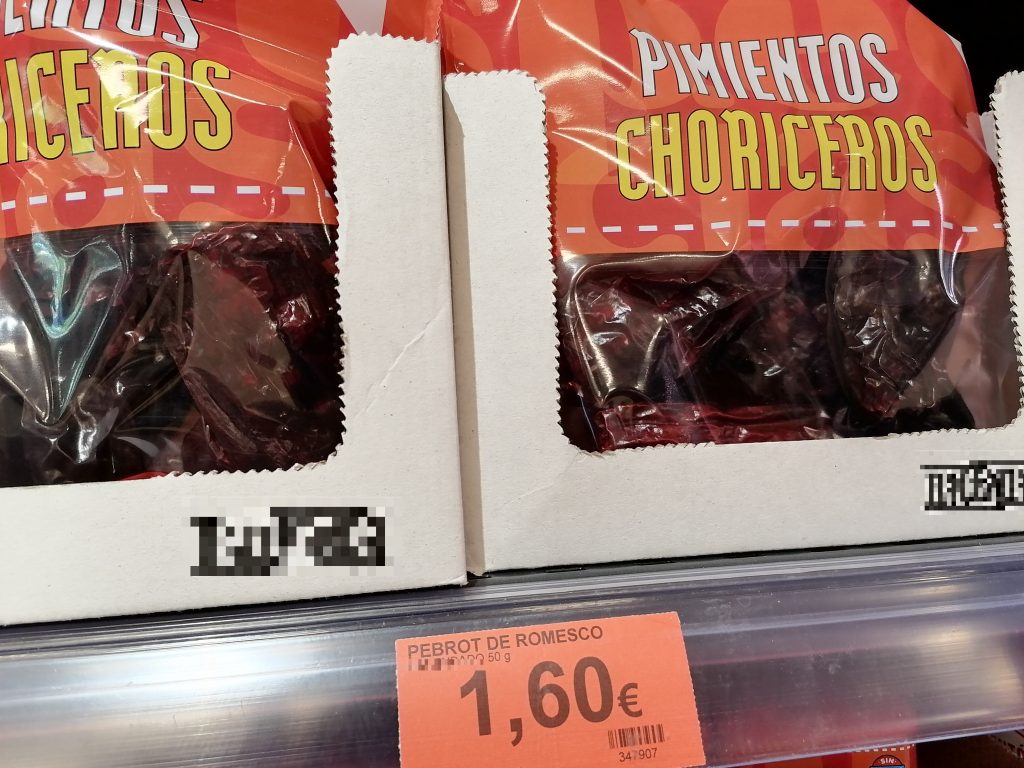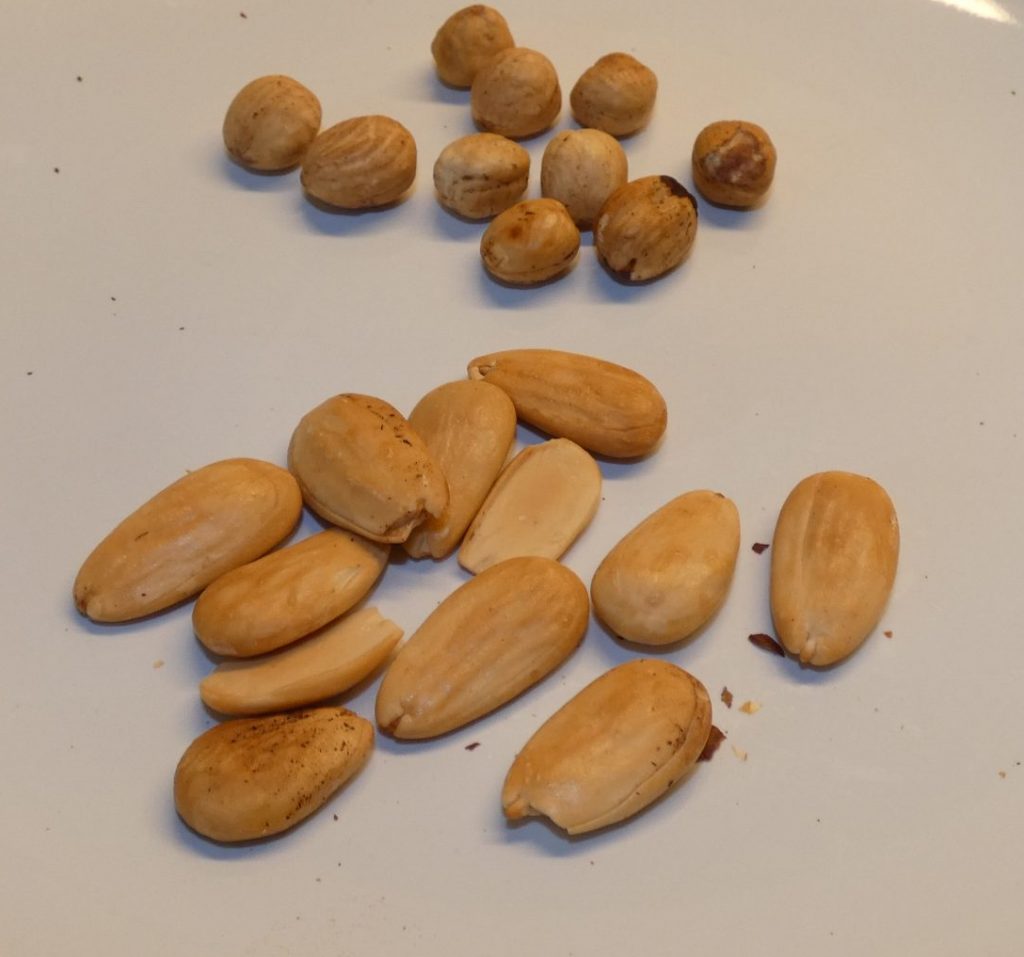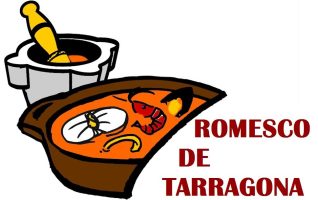As explained, the Romesco of Tarragona is based on the stir-fry of a characteristic mince, which serves as the basis for cooking a fish stew. Although quantities, forms and ways of making are as diverse as cooks, traditionally and in a general sense, Romesco is based on a series of common elements:
Ancho pepper: In Tarragona —and in general in Catalonia— it is called romesco pepper (pebrot de romesco or also pebrot de fer romesco) although it is the same product. It is a non-hot pepper that is used dry and has a subtle and fragrant aroma. Originally from America, it arrived in Spain in the 15th century after the Discovery and soon spread to France, Italy and Portugal, initially standing out for its medicinal properties. Its scientific name is Capsicum annum and it is widely used in other manifestations of spanish cuisine (Rioja, Navarra, Basque…) due to its great versatility. It is also used as an ingredient in the production of sausages. In Romesco, this dried pepper is almost always used open, clean of seeds and very lightly fried.

Garlic: a basic ingredient of Romesco that appears in the recipe in a relatively high proportion. Normally it is used in a combined way: both raw and also roasted or lightly fried.
Nuts: probably the ingredient with the highest local load, since the Tarragona region has a tradition of producing excellent nuts. Normally almonds and hazelnuts are used in the same proportion, being important that they are of the highest quality and freshness possible. For Romesco it is preferable to use toasted almonds and hazelnuts, rather than natural, salted or fried. It is striking that the amount of nuts is one of the factors that varies the most from one Romesco recipe to another. The recipes on this website propose quantities that are considered average.

Extra virgin olive oil: ingredient with a strong local personality too. A good olive oil, Arbequina if possible, is essential to ensure the quality of the final result, especially if it is used in just the right amount.
Spicy seasoning: in Romesco it will be used in a very measured way. The basic idea is to use the spicy seasoning but not to make the Romesco spicy, but to show a strong and robust flavor without being spicy. Sometimes it is said that a good Romesco can be a bit spicy at first, but as it is eaten, the itching sensation should disappear. To achieve this effect, very moderate amounts of chilli or peri-peri chilli will be used. Of course, there is no shortage of fans who make Romesco very spicy, under the well-founded idea that Romesco originally had to be a very rough dish.
Fried bread: in classic Romesco recipes it is always indicated to add thin slices of a loaf of bread to the Romesco base mix, which have been previously fried on both sides, usually with the idea of thickening the sauce and giving it texture. Typically these are thin slices of a 250 g loaf and they weigh about 10 g each slice. This ingredient should be used with care, as it is easy to abuse and thicken the stew excessively. In certain cases you can even do without bread.
White wine, stale wine or brandy: its main function is to dissolve the ingredients of the choppy to work it more comfortably. Although some classic Romesco recipes speak of using high-grade red wines, the truth is that these wines can greatly darken the minced base of the Romesco and prevent it from shining with its characteristic, lively and beautiful garnet red color.
Potatoes or cooked beans: they are frequently added in different proportions in order to make a more substantial and complete dish and provide it with a certain amount of carbohydrates. However, the romescos of the romescaires contests of Tarragona -which used to be monkfish- and also those of the historical recipes, do not observe the addition of potatoes or beans, but only carry the fish. The potatoes can be used in the Romesco, either raw, or having been lightly and previously fried in the same casserole.
Fish stock: there are romescos that use a mild fish stock in their final cooking and others that are simply made with water. This broth is obtained by boiling a series of fish of less commercial category, which are used especially for this purpose and that in fishmongers are usually known by the generic name of fish for soup. Today there are various commercial firms of ready-made fish stocks that can be a great and comfortable option. In these cases it is always better to bet on those that offer a minimum quality, since some of these prepared broths are practically based only on synthetic aromas and flavor enhancers.
Fish and shellfish: in this aspect the possibilities are diverse, because originally the Romesco of the boats welcomed any fish that was available every day without too much consideration, mixing some and other chopped species. It is generally said that a good Romesco should be made with fresh fish. Of course, fresh fish is excellent, both for Romesco and for any other dish, but it is not always available and will probably make the stew significantly more expensive. Nowadays, certain frozen or farmed fish or shellfish, which are currently offered in very interesting formats, with a very considerable quality and at affordable prices, do not have to be neglected in a Romesco project. Here are some types of fish that can be used in Romesco:
Monkfish. It is very common in Romesco, where it is used for its firm, compact meat with very little spine. Due to the amount of water that this fish contains in its tissues, it is a good idea to blanch it previously if possible, that is, keep the pieces submerged for a few seconds in a saucepan with boiling water before adding them to the stew, so that the monkfish lose some water and your meat slightly curdles. In this way the fish will not add extra water to the stew.
Turbot, sea bream or sea bass. Fish that are used clean and chopped. The enveloping skin of these fish helps to keep the slices whole during cooking. At present it is possible to get this type of fish quite affordably in its farm version. Although their flavor is not normally of the same level that their wild relatives enjoy, they offer to any pocket the possibility of using these fish in a Romesco.
Cod. The current relative accessibility of cod -which is also sold in pieces desalted to the point, boneless and frozen- makes it very suitable for a rich, simple and economically affordable Romesco. The piece of skin that cod slices generally keep on one side helps to prevent them from falling apart in the stew.
Mackerel, horse mackerel, sardines, tuna… Oily fish in general is not ideal for Romesco, as its flavor can be too intense and present. However, blue fish was usually used in the original romescos and there are those who do not want another Romesco that is not made with a good tuna or a fresh mackerel.
Cephalopods. Romesco can be made from cuttlefish, squid or octopus instead of using fish. In any case, even if the Romesco is fish, you can always add a certain amount of cuttlefish or squid to the stew. In romescos based on cephalopods it is advisable not to mix with each other (octopus with cuttlefish, for example).
Seafood and mollusks. The Romesco can be reinforced and garnished with prawns, crayfish, clams … which will always provide a cheerful touch and an intense flavor of the sea. Of course, these additives depend on each season and budget and are not at all essential to obtain a delicious Romesco; and in fact they are not considered in traditional recipes.

The base mixture of the traditional Tarragona Romesco was made, therefore, by patiently chopping garlic, fried bread, previously fried ancho dried peppers and nuts in a good mortar that could not be missing in every boat or in every house, and dissolving the result in wine or brandy. As you can imagine, this strenuous exercise of grinding in the mortar -which could take more than half an hour in order to reduce the mixture to a sufficiently fine and homogeneous past – has today been replaced by a stroke of an electric mixer. Nonetheless, a good romescaire should find, at least once in a while, an occasion to fully engage with his mortar, if only to remember the times when it was possible to afford to devote the time required to each thing. And there are those who assure that the difference is noticeable in the finish of the plate.
Once ready and diluted, the base Romesco mix is sautéed in the bottom of the casserole in a little extra virgin olive oil of the best quality and that is very hot, trying to cook it deeply but without burning or sticking. Then it is a matter of adding the fish, the broth and finishing cooking this great seafood stew from Tarragona.
